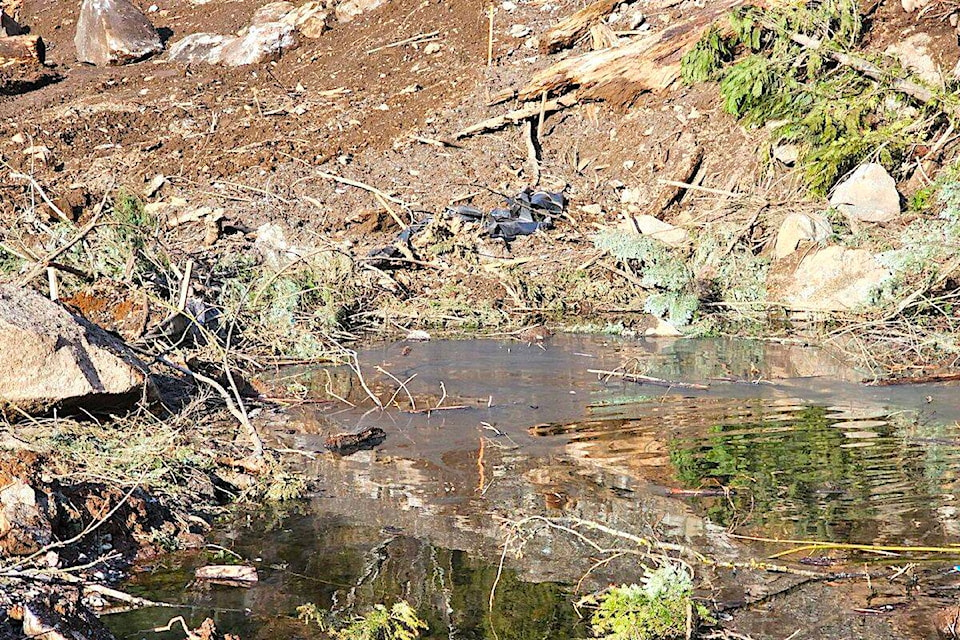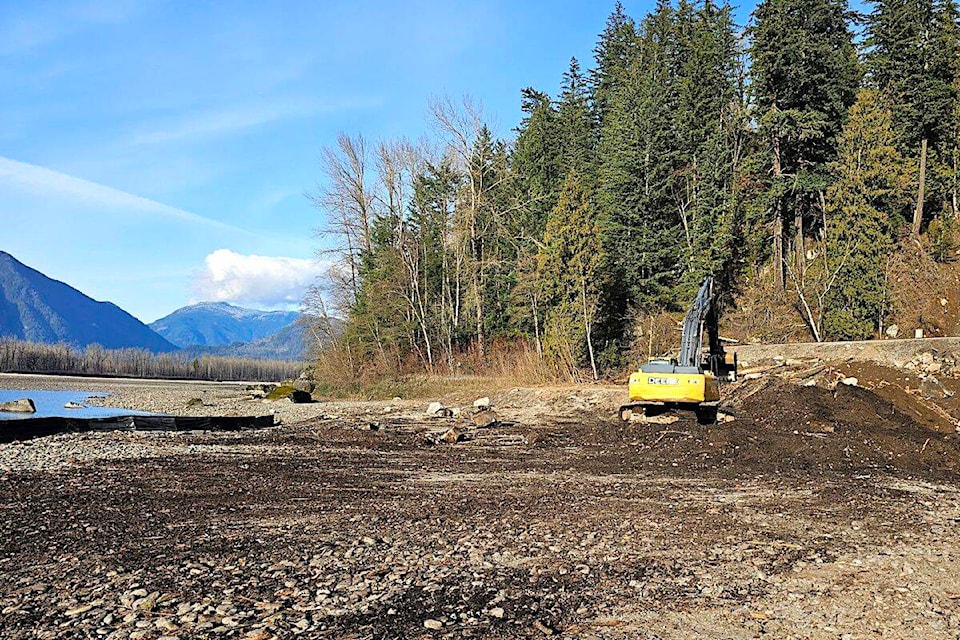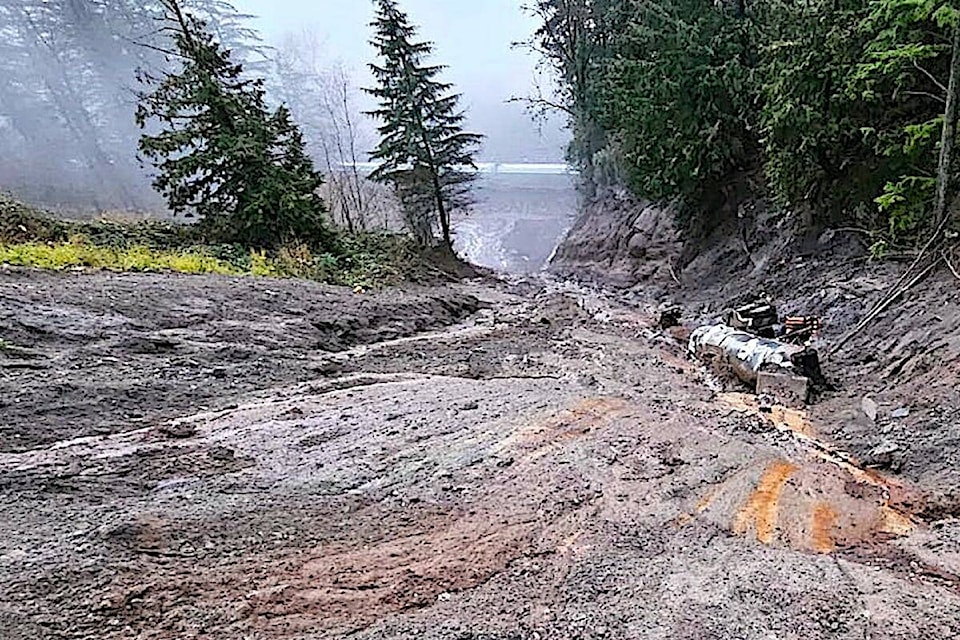It’s been almost three months since a potentially disastrous oil spill resulted from a landslide that came down above the Fraser River in Herrling channel, near Hope.
First Nations leaders are going public with their concerns in an attempt to spur immediate action at the spill site.
The landslide caused by heavy rains was reported to CN on Dec. 6. The slide caused an oil tank owned by a paving company to tumble down the slope, spilling an estimated 2,000 litres of waste oil.
The oil tank owned by Key-West Asphalt had a 20,000-litre capacity.
First Nations leadership in the area want provincial and federal agencies to take decisive action before the oil reaches the river.
Overall the spill response to date has been “slow and sloppy” and the inaction is a “clear demonstration of regulatory failure” mostly at the provincial level, said Tribal Chief Tyrone McNeil, president of the Stó:lō Tribal Council.
The emergency remediation finally obtained authorizations and got underway in early February. But when it was discovered the required geotechnical reports were not filed, a stop-work order was imposed by WorkSafe BC, causing the cleanup effort to be put on hold.
Spokesperson Ricky Dhatt of Key-West Environmental was briefly reached by phone, and he said that the oil tank in question was almost empty at the time of the spill, and that the waste oil “was not going into the water.”
But Indigenous leaders said the urgency arising right now is because spring freshet is on its way, and they want the work to resume. They also want the debris which included “microplastics” to be removed since it’s a threat to the best sturgeon habitat and spawning grounds on the entire Fraser River.

They’ve been on conference calls, and fired off letters, and have toured the site.
The waste oil is on the upstream side of the CN right-of-way, pooling in a ditch by a rail bed.
“We’re pretty confident that the oil has seeped into the ground, and is likely moving toward the river,” McNeil said.
They want test wells dug in to confirm but they need CN approval to do so.
As the lead agency on the oil spill, the B.C. Ministry of the Environment was asked by The Chilliwack Progress when the remediation work will resume, or if the province would take over the remediation process due to the delays.
Ministry officials in an emailed response clarified that MOE’s role is to: “follow-up on incidents, ensuring the public and our communities are safe, and environmental remediation is completed.”
“British Columbians expect swift action to protect the environment when spills and landslides occur,” according to emailed statement from MOE officials. “This is why we are holding Key-West Asphalt accountable for cleaning up waste oil that fell during a landslide.”
There is no threat to public safety from the spill, and in this case, Key-West Asphalt “was responsible for the incident,” ministry officials confirmed, and that includes management, and environmental restoration of the area.
“Key-West is working with their contracted geo-techs to remedy WorkSafe concerns and deficiencies. It is expected that on-site work will resume soon,” the MOE statement said.
The exact date is not known.
“Everything about the recovery has been slow and sloppy,” said McNeil. “I am astounded that DFO is allowing pickups, gravel trucks and machinery to travel through prime sturgeon spawning habitat willy nilly.”
McNeil said as soon as it was safe to start the work, he put in a request that DFO place straw bales or other mitigation methods on the ground to soak up the oil. He said “swamp mats” would help to create a path to minimize harm to the habitat before the equipment rolled in.
But that request not accommodated by DFO officials.
The lack of speedy remediation, and accountability by regulators prompted the Tiy’t Tribe to declare a state of emergency, with the Pilalt Tribe in support, and have asked the province to take over the site remediation, by invoking Section 87/88, of the Environmental Management Act, McNeil said.

There has been a total lack of cohesion in the response by the agencies.
“I’m really frustrated about the inability for the Ministry of Mines, Ministry of Environment, Transport Canada or DFO to compel activities,” McNeil said.
Seabird Island Chief James Harris said on the conference call that the oil spill site is directly across the river from his community near Agassiz.
“When the spill happened it wasn’t even reported until CN came across it,” Harris said.
And since then the spill response has been “pushed aside,” instead of being made a priority.
“It should have been a big concern,” Chief Harris said.
Skwah First Nation councillor Eddie Gardner said the absence of an effective response all this time has raised “serious accountability” questions, especially with the spring freshet just around the corner.
It needs to be seen as an emergency given the valuable fish habitat that’s been put at risk.
“It’s been a state of emergency ever since this spill happened, because we’re all concerned about taking care of our relatives. We consider our salmon and sturgeon our relatives.”
Seabird First Nation councillor Sally Hope said Fraser sturgeon should ultimately be recommended for listing under the federal Species At Risk Act, especially since there has been a “self-imposed moratorium” by the Stó:lō fishers who would have traditionally harvested sturgeon for traditional medicines.
The local leaders have been increasing the pressure on this file since January.
When the remediation finally got underway in early February, only to be shut down for lack of a geotechnical report, it raised their ire.
“Now it’s time for action,” Hope said. “We want to see some action on their part, and we want it quick.”
READ MORE: Train derailment in 2020 spilled potash
